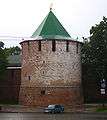Nizhny Novgorod Kremlin
| Nizhny Novgorod Kremlin | |
|---|---|
|
Native name Russian: Нижегоро́дский Кремль | |
 View of Nizhny Novgorod Kremlin | |
| Location | Nizhny Novgorod, Russia |
| Coordinates | 56°19′42.61″N 44°00′9.23″E / 56.3285028°N 44.0025639°ECoordinates: 56°19′42.61″N 44°00′9.23″E / 56.3285028°N 44.0025639°E |
| Area | 227 hectares (2.27 km2) |
| Built | 1508–1515 |
| Architect | Pietro Francesco |
| Governing body | kremlin.nnov.ru |
| Type | Cultural |
| Country | Russia |
| Region | Nizhny Novgorod |
 Central Nizhny Novgorod | |
The Nizhny Novgorod Kremlin (Russian: Нижегородский кремль) is a fortress in Nizhny Novgorod, the historic city center.
History


The first attempt to replace the wooden fort with a stone kremlin was recorded in 1374, but construction was limited to a single tower, known as the Dmitrovskaya Tower (this has not survived). Under the rule of Ivan III, Nizhny Novgorod played the role of a guard city, having a permanent garrison; it served as a place for gathering troops for Moscow’s actions against the Khanate of Kazan. In order to strengthen the defenses of the city, construction works on the walls began again.
Construction of the stone Kremlin of Nizhny Novgorod began in 1500 with the building of the Ivanovskaya Tower; the main work commenced in 1508 and by 1515 a grandiose building was completed. The oak walls that formed the old fortifications were destroyed by a huge fire in 1513. The two kilometer wall was reinforced by 13 towers (one of them – Zachatskaya – was on the shore of the Volga; not preserved, but was rebuilt in 2012). This “Stone City” had a permanent garrison with solid artillery weapons. With the fall of Kazan, Nizhny Novgorod Kremlin lost its military significance, and later it housed the city and provincial authorities.
The Council of Ministers of the RSFSR issued an order on January 30, 1949 for the restoration of the Nizhny Novgorod Kremlin.[1]
Towers
The following 13 towers survive. Counter clockwise:
.svg.png)
- Georgievskaya Tower (Russian: Георгиевская башня, lit. 'St. George Tower')
- Borisoglebskaya Tower (Russian: Борисоглебская башня, lit. 'Tower of St. Boris and Gleb') destroyed by a landslide in the 18th century; rebuilt in 1972)
- Zachatskaya Tower (Russian: Зачатская башня, lit. 'Conteption Tower') destroyed by a landslide in the 18th century; rebuilt in 2012)
- Belaya Tower (Russian: Белая башня, lit. 'White Tower')
- Ivanovskaya Tower (Russian: Ивановская башня, lit. 'St. John's Tower')
- Chasovaya Tower (Russian: Часовая башня, lit. 'Clock Tower')
- Severnaya Tower (Russian: Северная башня, lit. 'Northern Tower')
- Taynitskaya Tower (Russian: Тайницкая башня, lit. 'Secret Tower')
- Koromyslova Tower (Russian: Коромыслова башня, lit. 'Yoke Tower')
- Nikolskaya Tower (Russian: Никольская башня, lit. 'St. Nicholas Tower')
- Kladovaya Tower (Russian: Кладовая башня, lit. 'Pantry Tower')
- Dmitrievskaya Tower (Russian: Дмитровская башня, lit. 'Demetrius Tower')
- Porokhovaya Tower (Russian: Пороховая башня, lit. 'Powder Tower')

Georgievskaya Tower
St. George Tower
ГеоргиевскаяBorisoglebskaya Tower
Tower of Boris and Gleb
БорисоглебскаяZachatskaya Tower
Conception Tower
Зачатская_tower.jpg)
Belaya Tower
White Tower
Белая
Ivanovskaya Tower
St. John Tower
Ивановская
Chasovaya Tower
Clock Tower
Часовая
Severnaya Tower
Northern Tower
Северная
Taynitskaya Tower
Secret Tower
Тайницкая.jpg)
Koromyslova Tower
Yoke Tower
Коромыслова
Nikolskaya Tower
St. Nicholas Tower
Никольская_-_panoramio.jpg)
Kladovaya Tower
Pantry Tower
Кладовая
Dmitrovskaya Tower
Demetrius Tower
Дмитровская
Porokhovaya Tower
Powder Tower
Пороховая
Other buildings and constructions

The Kremlin contained many churches, but the only survivor is the Michael the Archangel Cathedral (the 'Archangel Cathedral'), built no later than the middle of the 16th century and rebuilt in 1628-1631. It is the oldest surviving building in the Kremlin. The cathedral contains the tomb of Kuzma Minin. In 1828, an obelisk in honor of Kuzma Minin and Dmitry Pozharsky was constructed in front of the Archangel Cathedral (architect Melnikov and Martos).
The house of the military governor was built in 1837-1841; it is now the Museum of Art. The Arsenal was built in 1840-1843 at the direction of Nicholas I. In 1931, the Transfiguration Cathedral was replaced by the House of Soviets; that building is now the City Council building.
In 1965, a memorial complex in honor of Nizhny Novgorod citizens who died in World War II was created, near the obelisk of Minin and Pozharsky; this included an Eternal Flame.
References
- ↑ Состоялась V Нижегородская межрегиональная архивоведческая конференция «Святыни земли Нижегородской. Нижегородский кремль», Nizhny Novgorod diocese, 1 октября 2009 года
